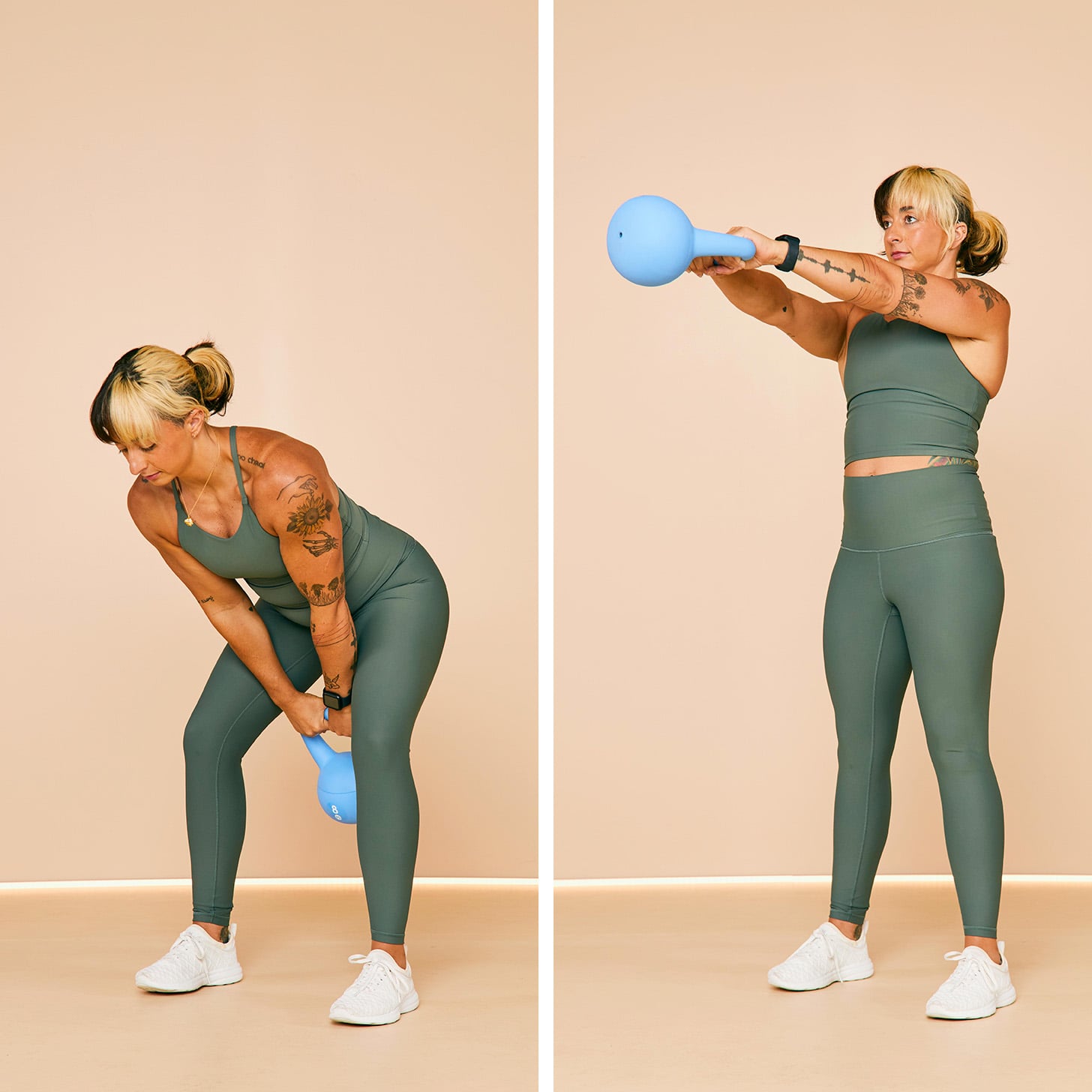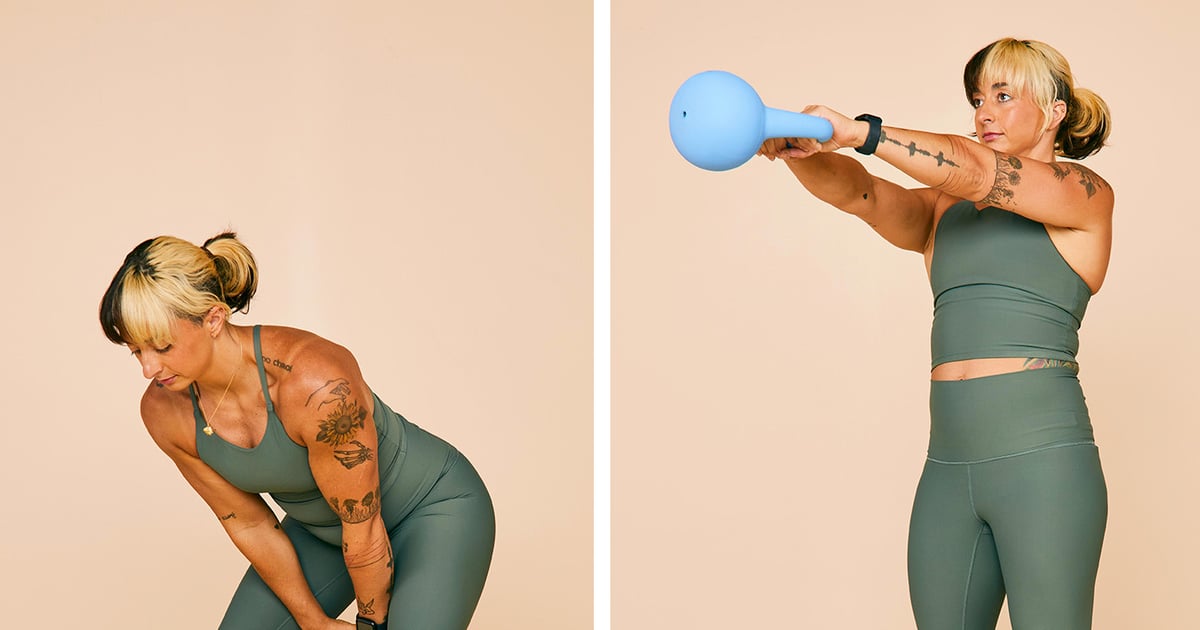Products You May Like

Strength, endurance, and power. These are the three components every good fitness program aims to improve. And one of the best moves to target all three at once is the kettlebell swing.
“Kettlebell swings give you a full body workout by combining both strength and cardio training. This improves your health and proprioception, which is the sense of self-movement, force, and body position” says Kemma Cunningham, CPT at Life Time Bridgewater. “You’ll also improve your explosiveness, attain greater stability along with better posture, and improve your cardiovascular system by increasing your heart rate.”
Kettlebell swings are also great for adding strength to your glutes, hamstrings, quads, calves, core, back, and shoulders. It utilizes the large muscle groups in your lower body and the posterior chain too.
In short: it’s a true powerhouse exercise. That said, it can be a little intimidating for people who aren’t accustomed to the move, and trying to add it to your workout repertoire without knowing the proper form can be a recipe for injury. So I’m breaking down exactly how to do a kettlebell swing to ensure you’re making the most of it. But first, trainers weigh in on the benefits of kettlebell swings. .
Kettlebell Swing Benefits
It’s a full-body workout
“Swings are an awesome movement for building total body strength and aerobic capacity”, says celebrity trainer Alfonso Moretti. “They roast your core and will make your whole body stronger. They engage the glutes, hamstrings, low back as well as abs,transverse abdominus and even shoulders a bit.”
It improves explosive strength
It’s all in the hips! Because of the hip thrust motion, kettlebell swings are a dynamic movement that can improve power, which will enhance your performance in daily activities.
It improves posture
“Swings performed properly help support proper posture by training the often-neglected muscles on the back of the body known as the posterior chain,” Moretti says. “Those muscles are important because they are in part responsible for proper alignment, strength and stability of the spine.”
It reduces risk of injury
Building muscle prevents age related muscle and bone loss. “Regularly training these muscle groups will also help to reduce the risk of injury by helping range of motion, balance and posture,” says Cunningham.
It improves cardiovascular output
Cardio doesn’t have to mean running. Kettlebell swings are a move that really gets your blood pumping. It doesn’t take many repetitions to get your heart rate to climb.
How to Do the Kettlebell Swing
In order to tap into the benefits of kettlebell swings without risking injury, it’s important to be strict with your form. “There are many ways you can miss the mark on the kettlebell swing,” Cunningham warns. “Swinging the kettlebell too fast with no control; not hinging at the hips; leaning back too far in the upright position; no follow through at the hips; allowing the kettlebell to droop and point down, not forward [during the upward portion of the swing]; or using too heavy of a kettlebell when you haven’t mastered the proper form with a smaller weight can all lead you down the road to injury.”
With that in mind, here’s how to do a proper kettlebell swing.

- Start with your feet a little wider than hip width apart, holding a kettlebell in both hands.
- Hinge your hips back, with a slight knee bend, and bring your chest forward, while swinging the kettlebell back between your legs.
- Driving through the heels, thrust your hips forward by squeezing the glutes and swing the kettlebell up in front of you. Do not go above shoulder height.
- Allow the kettlebell to swing back down with control, returning to your starting position. That’s one rep.
Kettlebell Swing Modifications
The kettlebell swing is a tough exercise, so if you find you can’t keep proper form while holding a lighter KB, start with one of these modifications first.
Bodyweight Swings
Repeat the steps of a standard kettlebell swing, but with no kettlebell to practice form, Moretti suggests. This can go a long way toward building confidence and helping your body learn the motions. Once you feel more confident, start by adding a very light weight.
Romanian Deadlift
A Kettlebell Romanian deadlift uses the exact same hip hinge and lowering of the weight, but you stand upright to finish the move instead of swinging the weight forward. “It’s a slow motion version of the swing, which teaches hinging at the hip while keeping the spine neutral,” Cunningham points out. A primer on how to perform the move is here:
- Start by standing with your feet shoulder-width apart, toes facing forward, holding a kettlebell with both hands, palms facing your thighs.
- Squeeze your shoulder blades together and engage your core without holding your breath. Ensure there is a slight bend in both of your knees and inhale while you slowly sit your hips back.
- Lower the kettlebell along the front of your thighs, keeping the weight close to your body. Stop when the KB is just below knee level — or until you feel a slight stretch in the back of both thighs, whichever comes first.
- Exhale and drive your hips forward to return to standing.
Adjusted range of motion
If you’re a beginner or have a limitation due to injury, start with a shortened range of motion and slower movements, Moretti says. For instance, you can lift the kettlebell to a lower point during the upward motion of the swing, and hinge your hips less far back.
Kettlebell Swing Variations
Again, don’t rush perfection. First, focus on getting comfortable with a standard kettlebell swing. Because it’s a relatively complex and hardworking movement, you want to master it before thinking about upping the intensity. But once you’re ready:
Weighted or High-Rep Swings
“You can always take your kettlebell swing to the next level by increasing your kettlebell weight and reps,” Cunningham says. Challenge yourself, but never increase your weight to the point that you’re unable to keep good form.
One-Armed Kettlebell Swing
Repeat the steps to performing a standard kettlebell, except instead of holding the kettlebell with both hands, hold it in one, keeping your other hand out to your side, perpendicular to your body for stability. However, you must keep in mind that when you’re only using one arm it’s even more important to utilize correct form.
Brittany Hammond is a NASM-certified fitness instructor, a fitness writer, and an avid reader. In addition to POPSUGAR, she has contributed to Livestrong.com, Well+Good, Verywell Fit, and Health.com. She has worked as a group fitness coach for the past seven years.
Image Source: POPSUGAR Photography / Chaunté Vaughn
